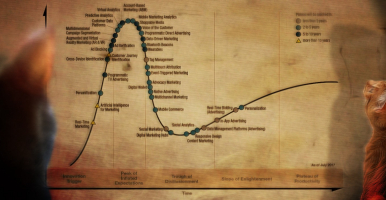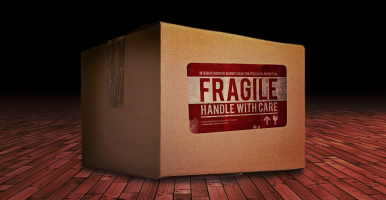Redefining the Agency-Of-Record
Observations from the factory floorThere is an on and off debate about the future of the Agency-Of-Record model. The other day this article argued for firing the AOR and switch to a team of specialists instead.
According to a recent survey by The CMO Club of 106 CMOs few are actually satisfied with the AOR model. The most common reasons is a lack of innovation (55%) and narrow capabilities (35%). Agency collaboration seems to be the new normal.
An agency ecosystem?
There are some good thoughts in the report about how to create an agency eco system. Well, at least in theory. Based on my experience and life at the end of the food chain (i.e. production) I can say that most theories stay as catchy phrases on the management level and the positive effects on the factory floor are not that clear.
Because they should be noticeable, right? If the theories worked we should all talk with the brand voice, be super creative and produce award winning work. What I most often see instead is a lack of collaboration and coordination, everyone works in their own silos. There is little to connect it all.
So here is my defence for the AOR, not the old one, expensive, slow moving, bloated, but a new, nimble, creative, strategic one that connects the dots.
An AOR for the future!
Size matters
Before digging any deeper, let’s just acknowledge: size matters. Small companies can have a marketing team of one and an AOR of zero so you just have to do the work. If there is an agency involved it must of course know and do “everything”.
In the upper end there is a size where everything breaks down and grinds to a halt. There is simply too much work to be done to be able to use a generalized form.
So here is for the 95% in between.
Fragmented marketing

The marketing landscape has been seriously fragmented the last couple of years because of digital. All these new channels, each with their own set of mechanics, demographics, technologies has led to a situation where it is impossible for a single human to grasp it all.
Since everything has become so fragmented the experts themselves have had to focus on smaller and smaller segments. Whoever you talk to will already have picked a niche.
Should we ask the Influencer Agency whether influencer marketing is a good way to go? Or someone focusing on emerging tech if AR is right for your brand?
People are not evil but they are not stupid either. Of course they want to sell their services, and of course they happen to be “the future or marketing” and “the best fit for the brand”.
So what is actually the problem?
It is easy to perceive this as a technical challenge. Or a media challenge. Or a demographics challenge. If we only bring in a partner that knows x/y/z then everything will work great.
If your goal is to produce relevant content for SnapChat, then yes that might work. But if the goal is to create the best marketing for the brand?
If everybody is experts and specialists then no one is actually responsible for the overall marketing strategy.
The argument for an AOR

The strongest argument for AOR is the alternative. The brand must communicate with a number of agencies, all with their own expertise, agendas and priorities. Ideally the agencies need to communicate with each other, coordinate, collaborate. Good luck with that.
Regardless of what some say, this is not an ideal setup and the map is just about get more crowded. A future where marketing is created in global collaboration between specialized agencies sounds like a management and procurement hell.
Redefining the Agency-Of-Record

For the AOR to save the day they must be able to be the single point of contact for the brand. It seems like that is quite far from the case today. The current AOR model cannot deliver creative and strategy to cover all needs for a brand. So what has to change?
The next generation of AOR…
…is lean, nimble, creative, strategic
The future AOR is responsible for the overall marketing strategy, whatever channel. The only constant of the future is change, so the agency must be able to evolve quickly, absorb new trends, channels, user behaviors.
…creates integrated marketing strategies
Integrated, meaning all channels work together towards the same goal. The AOR builds the foundation and then select whatever channels and media that best fit the need. The AOR should be the author of the book.
It is not only about the message, it is about synergies on all levels, creating efficiencies and cost savings, and opening up new creative opportunities.
…is media and channel agnostic
The AOR must be generalists and cannot specialize on e.g. content, social, experiential, emerging technologies, digital. Because if they do, how can they deliver the strategy that is best for the brand? And how can they adapt to an unknown future?
The complexity of the media landscape will always require experts and specialists. The AOR should be the link between the brand and these experts.
…does not have in-house production
Buying MediaMonks is a bad idea. Not for the buyer who will remove external costs and add new revenue streams, but for the client. Here is a list of no’s:
- it makes the organization bigger and bloated, which makes it slower to catch on new trends and technologies
- strategies are adapted to generate revenue for production.
- the production is no longer best-in-breed, only best-in-house
No dead meat, it might be good business for the agency but not for the brand.
…does not work in projects
Project based work creates the wrong incentives. It is no longer about finding the best solution since there is a financial bottom line that taints the decisions. Project based work is also a fool proof way to create inconsistent communication and marketing.
Conclusion
As I said, this is based on my observation from the outside. I know that I am simplifying, generalizing, there are a million other challenges that I have willfully ignored or am happily unaware of.
In any case, it is an interesting creative challenge for the future, because something has to change. It looks like an amazing opportunity from where I stand!





